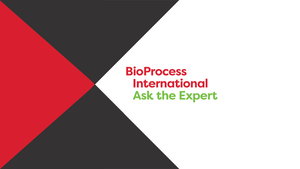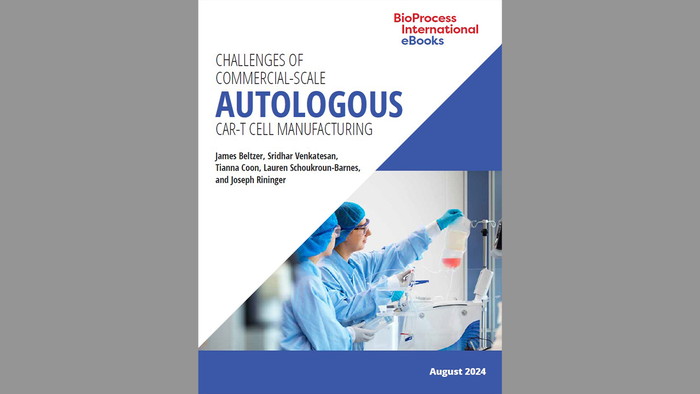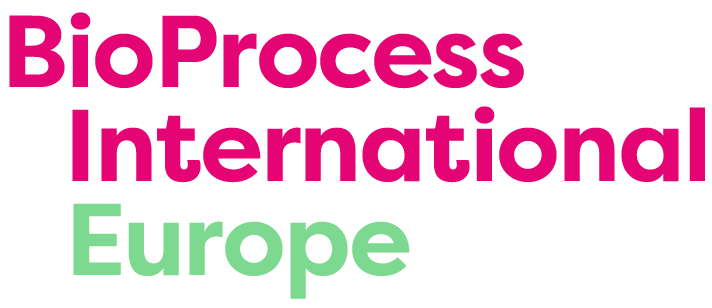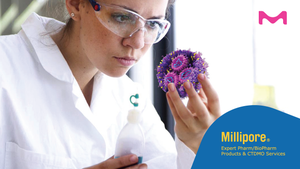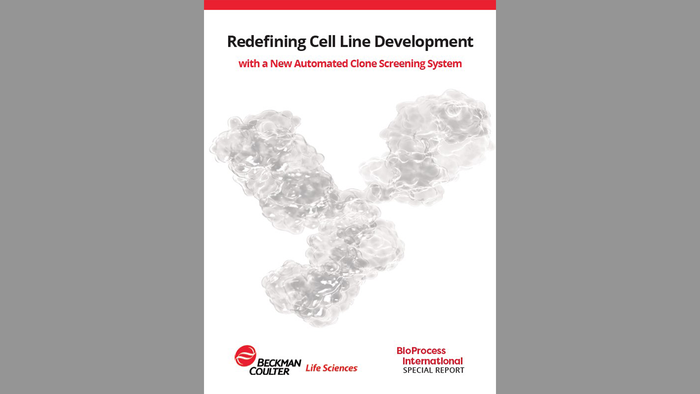Vision and Challenges for the Future of Biopharmaceutical ManufacturingVision and Challenges for the Future of Biopharmaceutical Manufacturing
.jpg?width=700&auto=webp&quality=80&disable=upscale)
The National Institute for Innovation in Manufacturing Biopharmaceuticals (NIIMBL) held its annual National Meeting in June 2024 to explore key issues in the manufacture of novel biotherapeutics and vaccines.
In the development and manufacturing of innovative biotherapeutics and vaccines, many US-based and globally acting companies can look back on decades of experience that stress the importance of optimizing three pillars that are foundational to success: quality, speed, and cost. Such optimization has become challenging in today’s biopharmaceutical landscape as the industry anticipates future epidemic and pandemic scares, leaps into novel treatment modalities, reacts to infrastructure and supply-chain disruptions, and troubleshoots dynamic shifts in workforce demands.
The National Institute for Innovation in Manufacturing Biopharmaceuticals (NIIMBL), a public–private partnership and one of Manufacturing USA’s 18 national institutes, held its annual National Meeting in June 2024 to explore those issues. Comprising companies that develop and manufacture biotherapeutics and vaccines as well as organizations that provide specialized manufacturing equipment, supplies, services, and facility designs, the NIIMBL community represents a cross-section of stakeholders immersed in the transitions facing the biomanufacturing industry.
Three sessions at the National Meeting convened senior industry leaders to enable deep dialogue on the current visions and challenges to the future of biopharmaceutical manufacturing. Speakers shared concerns in relation to cost of goods (CoG), risk management, continuous operations, shifting roles of platform manufacturing, gaps between data and process sciences, changing demands for workforce skills, and silos that obstruct much-desired progress. A unifying theme that emerged across those diverse topics was the opportunity to address widespread challenges with novel partnerships established at early, precompetitive stages. Herein, we highlight key points and pressing issues from the sessions to share solutions that depend on collaboration across the industry.
The Changing Culture of CMC Development
The trajectory of chemistry, manufacturing, and controls (CMC) development in biopharmaceutical manufacturing is one of high speed and complexity. The importance of speed unquestionably is driven by the need to keep CMC deliverables as much as possible off the critical path of any clinical program. Rapid vaccine development during the COVID-19 pandemic also demonstrated the possibility of expediency, whether or not such speed was sustainable.
Complexity continues to rise with the expanding variety of molecular modalities that require changes to otherwise heavily platformed unit operations. Bioprocess technology and synthetic chemistry have converged to the extent that traditionally defined lines separating biologics from small molecules — and their respective research and development (R&D) departments — increasingly are blurred. We anticipate an expansive future in which any modality and combination thereof is theoretically possible, bringing opportunities but also challenges. “The desire to treat disease is strong,” explained Paul Collins (vice president at Eli Lilly and Company). “That hasn’t changed, but the expectation going forward is that we will use any modality of treatment possible.” Tom Piombino (managing director of Integrated Project Services, LLC) shared a similar perspective from his experiences in process architecture: “I’ve been in the business for 30 years. I probably work on 60 to 70 [facility] layouts a year. I see lots of different modalities from gene therapies to antibody–drug conjugates (ADCs) to biologics, and I’ve never seen such a fusion of all those modalities coming together.” Collins noted that novel modality combinations ultimately “[are changing] the culture around how CMC should be done.”
Such shifts have escalated the challenge to developing flexible manufacturing solutions, product-agnostic unit operations, and analytical methods: “Many of these modalities did not even exist 10–15 years ago in the drug-development space,” explained Ranjeet Patil (senior director of strategy and transformation at Waters Technology Corporation). “Now, the existing techniques have limitations on their ability to detect and accurately analyze these entities. So, it’s not just a matter of having the tools, integrating them, and making sense of the data. For in at least several cases, the technologies themselves are not suitable.” That trend will influence the entire ecosystem, including manufacturers, suppliers, analytical-service providers, and regulators. As the industry maintains the drive toward ever-faster CMC development, it is imperative that it happens without loss of effective end-to-end control strategies and operational integrity. Speed, quality, agility, and value need to be maintained and optimized in lockstep; and quality is a sine qua non — the license to operate.
CoG is an urgent pressure point, particularly given the recent extended period of high inflation. “Our industry is extremely capital intensive,” noted Patil. Jon Coffman (executive director at AstraZeneca) devoted his talk to antibody manufacturing: “One of the things I think about a lot is how we can get CoG down to US$10 a gram,” he explained. The entire ecosystem has experienced higher costs of materials and equipment, low appetite for capital investments, and a period of reduced funding opportunities for new entrants into the biotechnology industry.
Speakers posited partnership as key to offsetting budget and other constraints. Daria Fedyukina (project manager at the Advanced Research Projects Agency for Health, ARPA-H) discussed how her agency focuses on advancing biomedical and health research and targets funding support toward “areas where there is too much risk for any given stakeholder.” Speakers agreed on a number of beneficial scenarios: small companies with bespoke capabilities partnering with large ones, experts in biologics and synthetic-molecule development learning from each other, companies bringing in customers and academics, and organizations reducing CoG not merely for business and profit but also for equity to bring global access to vaccines.

Jon Coffman (executive director at AstraZeneca) discussed the possibility of decreasing the cost of goods (CoG) for monoclonal antibody (mAb) manufacturing to US$10 per gram in the age of high inflation.
New Developments in Platform and Flexible Manufacturing
Speed: The urgent response to the COVID-19 pandemic redefined the industry’s role in making effective vaccines and drugs available rapidly. Within hours of the SARS-CoV-2 sequence’s publication in January 2020, several groups realized (based on prior experience with coronaviruses) that the surface spike protein was an excellent target for creating a vaccine; a protein-based vaccine became the logical path forward. In an unexpected outcome, two alternate approaches proved to have shorter timelines than making the protein antigen. The first approach used mRNA delivery (Pfizer–BioNTech and, independently, Moderna). The second approach was based on replication-deficient adenoviruses, which were developed by an Oxford University team collaborating with AstraZeneca and by Johnson & Johnson. Collectively, those vaccines were provided at a scale of billions of doses; now, both approaches can be considered platforms.
Manufacturers achieved flexibility in their facilities by making extensive use of single-use equipment. Unit operations with closed connections are protected from external contamination, resulting in facility layouts resembling ballrooms with multiple unit operations running in the same room (1). Piombino noted that his customers valued having a single point of contact for communication with government regulatory agencies: “[We’re] trying to convert to a nonclassified environment” for knowledge-sharing that leads to “a discussion with the FDA [US Food and Drug Administration]” as a means to get feedback. “NIIMBL is uniquely positioned to have that conversation,” Piombino added.
Emerging Technologies: Many NIIMBL member companies represented at the National Meeting develop and manufacture monoclonal antibodies (mAbs) at large scales. In nearly every case, mAbs are made by fed-batch cell cultures based on Chinese hamster ovary (CHO)–cell platforms using several standard unit operations (e.g., protein A affinity chromatography for primary purification). Switching from fed-batch processing to continuous operations can help to reduce facility sizes and CoG. Thus, several NIIMBL member companies are looking to make such a switch in antibody manufacturing.
Although many of the member companies that design and make equipment have interest in process patents, those companies still share knowledge about technology developments, thereby building platforms that perform better and allowing new products to get licensed and introduced more rapidly. As Coffman noted, “I 100% agree on the value — certainly to [biopharmaceutical] companies — of allowing broad use of innovative technology.”
New developments in platform manufacturing will include revisions to how regulatory agencies view the role of prior knowledge and commercial experience. The FDA has issued proposed guidance on platform technologies (2). The proposed document “Guidance for Advanced Manufacturing Technologies Designation” would create a pathway for review of new technologies that is independent of biologics license applications (BLAs) (3).
Environmental Concerns: Extensive application of single-use equipment leads to the common problem of how to handle remaining plastic waste. “We’re all driving toward carbon-neutral bioprocessing,” said David Pollard (head of advanced bioprocessing at Sartorius Corporate Research), “but obviously an element of this needs to come from plastics recycling. Corporate research is passionate about making this successful.” Pollard shared Sartorius’s recent successes with recycling polycarbonate from automated bioreactor systems and mechanically breaking down film plastics. Pollard also used the opportunity at the meeting to solicit partners: “I really need help from the community here . . . to put a pilot plastics collection and sorting process in place . . . on the East Coast and West Coast of the United States.”
Jerome Bill (director at Genetech) emphasized the widespread investment in sustainability: “Whether it’s academia, vendors, [or] industry, everyone’s talking about sustainability right now. With that industry-wide focus and legislation driving changes, it’s going to push sustainability.” Addressing the challenge of recycling plastics is an ideal project for a consortium approach. Through its process-intensification program and funded projects, NIIMBL has focused on sustainability, establishing partnerships to develop models for process developers. Speakers discussed NIIMBL’s ability to bring together multiple biopharmaceutical companies, equipment-supply companies, and regulatory stakeholders to accelerate technology development of single-use equipment that can be recycled fully. Industry-wide process-intensification efforts aim to address sustainability in parallel with demands for higher productivity, lower CoG, and increased support for pipeline complexities. Bill noted the opportunity in recent advances: “We have new tools, processes, and metrics to measure and manage our impact on sustainability. That allows vendors to develop better direct materials. It allows our development organizations to develop better processes with sustainability in mind. And as we’ve already seen from next-generation facility designs, we have the ability to cater our manufacturing facilities towards the significant contributors to sustainability such as saving water or saving energy.”
.jpg?width=700&auto=webp&quality=80&disable=upscale)
Tom Piombino (managing director of Integrated Project Services, LLC) discussed fusion modalities from a chemistry, controls, and manufacturing (CMC) perspective.
Technology Transfer, Comparability, and Quality
Advances in vaccines, gene therapies, cell therapies, and therapeutic proteins raise the stakes for quality control. Those modalities differ in complexity. For example, if the product is a peptide, then its developer probably can claim that the product is well characterized so long as typical analytical technologies are used appropriately. Therefore, bridging a technology transfer can be based primarily on analysis of final products.
For an inactivated or attenuated viral vaccine, that claim is far more difficult: “What I have always wanted from PAT [process analytical technology] is that kind of rapid ability to understand if a product is under control based on a quality-indicating parameter. That’s what’s been hard in the biologics space — having tools that get at those parameters really well,” noted Collins. Analytical tools play key roles in rapid process development and high-quality vaccine manufacture (4).
“We really believe automation is going to drive a lot of the success toward low-cost, new modalities, and we’re working toward self-driving processes, autonomous processes,” Pollard shared. Fedyukina described her agency’s enthusiasm to fund out-of-the-box ideas that would speed up control processes, asking, for example, “What if release testing could be done in one hour —release testing for gene therapy — to make it quick, make it efficient?”
An industry-led steering committee established through NIIMBL is identifying high-priority projects for funding around analytical characterization of vaccines. A new vaccine analytical-characterization laboratory at NIIMBL headquarters in Newark, DE serves as a key resource for partnership through that vaccine initiative.
Nontraditional Investments in Pandemic Preparedness
Organizations such as the Biomedical Advanced Research and Development Authority (BARDA) in the United States have identified pandemic preparedness as a key goal. After a declaration of a pandemic by the World Health Organization (WHO), the race is on to develop and manufacture safe, effective vaccines at huge quantities. Continuing concerns over harmful pathogens have sparked diversity of investment and approach for pandemic preparedness: “Now you have not just big pharma, but also [small] biotech companies engaging in vaccines, and certainly there are alternatives, not just the classical prophylactic vaccines,” explained Hao Chen (assistant vice president of vaccines and advanced biotechnologies process R&D at Merck).
To respond efficiently to health crises, organizations require several key capabilities. Agile discovery groups are needed to create product candidates and generate critical reagents, such as antibodies needed for developing potency assays. Ideally, vaccine candidates are developed by leveraging platform technology that already has been developed and tested at scale in a large, good manufacturing practice (GMP)–compliant facility. For instance, developers now are leveraging mRNA-based vaccine platforms such as those established by Pfizer–BioNTech and Moderna during the COVID-19 pandemic. In those cases, the timeline from antigen discovery to production of tens of millions of doses per month was less than a year. The Coalition for Epidemic Preparedness Innovations (CEPI) provides funding to help biomanufacturers generate tools for vaccine-based solutions that take less than 100 days from declaration of a pandemic to vaccine availability (based on emergency-use authorization, as appropriate) (5).
Health authorities can respond rapidly to future pandemics caused by influenza viruses or coronaviruses. However, if a novel pathogen suddenly circulates, then timelines would become more variable. Human immunodeficiency virus (HIV) provides a sobering reminder; patients still do not have an effective vaccine after 20 years of investment. Patients rely on lifetime treatments with chemically synthesized antiviral drugs for disease control. Work is being done by VIR Biotechnology in that domain, but as Eric Fallon (vice president of bioprocess development at VIR Biotechnology) noted, partnership is key: “partnerships for development and manufacturing, but also many nontraditional partnerships in the CMC space.” Chen likewise characterized the race for vaccines as a partnership: “We’re not competing with each other. We’re competing with the disease.”

From left to right: Joey Studts, Rick Morris, Michael Phillips, David Pollard, and Eric Fallon.
Holistic Approaches to Workforce Development
Speakers at the meeting addressed the urgency of attracting, training, and retaining a workforce with skills relevant to address the ever-increasing complexity of biomanufacturing. Many organizations have initiated new recruiting methods — e.g., targeting community colleges, broadening the number of universities where companies recruit, and expanding R&D footprints geographically to locations with large talent pools such as San Diego, CA and Boston, MA. Having a breadth of perspectives is a shared goal to lead to stronger solutions for technical challenges. Speakers reported having recruiters work aggressively to get resumés of applicants with varying backgrounds and experiences before interviewing. Recruiting more experienced and/or postgraduate talent is also a difficult and lengthy process in the current environment, but it is important for organizational success and ensuring good role-modeling for junior staff.
Several industry leaders are looking to Germany, where an established apprenticeship and work–study system is a model for creating a similar approach in the United States. Joey Studts (director of downstream development at Boehringer Ingelheim) noted that because internships are integrated firmly into the training pipeline in his German company, he must limit the number of privately recruited interns on his teams. Building dynamic teams in growing areas, such as microfluidics and process automation, calls for collaboration among industry and academics to establish ways to increase capability in educational programs that have such key areas in mind, noted Pollard. Instituting educational tracks that specifically train for apprentice technical roles such as qualified laboratory technicians, would resolve challenges building this sector, he continued. Such tracks would ease filling those roles by sourcing well-trained candidates from a broad, diverse base.
Just as important is talent retention. As noted by Fallon, this calls for “having a culture where people can bring their whole selves to work, an environment where people feel they can really be themselves.” Retention, many speakers emphasized, is about supplying opportunities to move within an organization, providing tools for professional development, and instilling a learning environment for people. Creating organizational cultures that keep people throughout their career ensures that role models are sustained, especially when there is conscious emphasis on and support for experienced professionals staying current with next-generation approaches and technologies.
Practically speaking, companies seek to extract knowledge and decision power from a rapidly increasing wealth of data. To facilitate that, people need to develop skills for working across different areas and levels of experience. Some organizations have instituted rotational development programs, particularly so that managers can receive hands-on experience in different groups across R&D sectors and learn how different areas connect.
Increased consistency in biomanufacturing training programs could be developed through nationally accessible training centers for the current and future workforce, paired with the ability to rely on standardized competency and skills assessments, including a reliable system of credentials to provide transparent evidence of workforce-readiness. “Workforce is a high priority for [implementing Sartorius’ sustainability initiatives],” noted Pollard, “and we’re very active in the NIIMBL workforce team.” Likewise, NIIMBL’s training database, funded by the Gates Foundation, allows members to exchange resources around professional development, academic programs, and career services (6).
Connected Flows in Data Science and Digital Solutions
Discussions on the future of biopharmaceutical manufacturing inevitably include the recognition of the importance and promise of data science and digital solutions. A great opportunity lies in closing the gap between data and process science, from digitization to expansive use of artificial intelligence (AI) and machine learning (ML). Pulling in mechanistic and statistical modeling is just as relevant as continuing to focus on data analytics, process and plant automation, and robotics. Studts shared ways that data are driving technology development for his company: “We’re trying to take these two technologies — mechanistic modeling so that we can provide more predictive power to our data and PAT with Raman spectroscopy to have more data from an experiment — to understand the data that we’re getting and be able to use live, on-line data to make better models.”
Although PATs are not new, industry attendees expressed the need for more efficient PATs and noted that legacy infrastructure can raise frustrating obstacles toward implementing such improvements. The vision of the future includes “just-in-time technical wisdom” enabled by connected tools, integrated workflows, and simple user experiences.
A consequence of the interest in continuous manufacturing is the need to link data in real-time from one unit operation to the next. That leads to the emphasis on standardization and the importance of compatible data-handling platforms. “I think it’s definitely the standardization and the openness in terms of sharing these learnings [that will be critical], so forums like NIIMBL meetings are definitely a part of the solution,” said Patil. The discussions at this particular meeting highlighted the desire to achieve efficiencies by driving toward practical standards and consistent structure in data ontologies, ultimately with an eye toward enabling “one-click” technology transfers, reduced cycle times, and regulatory convergence.
Michalle Adkins (director of life sciences strategy at Emerson) remarked on the common interest in “the ability to share data anonymously. That’s going to be helpful for the whole industry and will ultimately benefit patients.” Piombino agreed, highlighting the importance of NIIMBL’s big-data program and its efforts to establish consistent data ontologies: “We need to be able to get that data with context in some kind of a common format, with some commonalities that you can make sense out of it.” That too relies on a commitment to partnership. As Fallon summarized, “If everybody says we’re going to do this in a common way with a common vernacular and common tools, everybody wins.” Studts described an aggressive publishing strategy to share the models that his company developed with NIIMBL support. His company also included those models in a BLA, with the understanding that “Boehringer going it alone would have been a much more difficult path.”
The “facility of the future” must continue to mature from “digital islands” to connected, predictive, and ultimately adaptive plants. A significant breakthrough for the industry could come from a future state of flexible manufacturing networks, in which investments are decoupled from technology transfer (e.g., success milestones of specific products in a pipeline). Patil shared such a vision for transforming the industry: “In the ideal world, we will be able to deconvolute the process and product. And if we are able to overcome that dependency [on inflexible infrastructure], we can be bolder in our process choices. We can be more ambitious in our process design and more efficient in the productivity. Analytics are what we believe are the key enablers of that transformation.” The translation of factory operations into digital twins and the desire to leverage more extensive mechanistic and/or empirical modeling also present new opportunities to engage with academia.
Speakers weighed the challenge their companies faced to make this major transition on their own or work together: “It’s a big lift for tool providers to be able to adapt to those standards because of limited resources,” noted Wayne Heacock (biopharmaceutical market specialist at Agilent). “Organizations such as NIIMBL are incredibly valuable this way. We need to figure out a way to collaborate a little more closely or, though it might seem radical, consider cost sharing to raise the boat for everybody.” The current atmosphere of accelerated manufacturing brings risk, noted Collins, “so you have to free people up through central groups that make it a little safer for us to try things together.” Using a consortium can reduce risk.
Pollard asked, “Can there be more pressure on regulatory agencies to come up with some incentives to drive end users to be those first adopters of new technologies and workflow solutions?” A consortium can enable companies to work together to develop pilot-scale prototypes, as was the case with NIIMBL’s process-intensification initiative.
Rapid prototyping is essential in this environment. “An innovation sandbox is critical,” explained Michael Phillips (technical director for innovation at MilliporeSigma/EMD Serono). He said that NIIMBL provides valuable support as a precompetitive consortium that connects allies to use test beds and derisk innovation to achieve proof of concept. As Studts remarked, “What drove us to come to NIIMBL was the extensive collaboration network of industry and academic colleagues to help drive innovative ideals. We need more data faster to understand how our models are working, why they are working, and when they’re not working.” And Phillips explained, “What you’re doing is changing something that’s theoretical into something that’s experiential. A proof of concept is really worth a thousand words in so many different ways. It not only supports technical feasibility, but also helps you to identify gaps and opportunities. It helps derisk implementation. It helps demonstrate value. But most importantly, it helps create allies.”

From left to right: Wayne Heacock, Michalle Adkins, Tom Piombino, and Ranjeet Patil.
Partnership in Innovation
Although the “arrows” of speed, quality, and cost do not necessarily point in opposing directions, flexibility is needed in carefully managing constraints. In today’s world, flexibility may best be seen as a rightful “fourth pillar” that can address the urgencies and innovations in the field to deliver concrete societal advantages. This is certainly the case in an environment where systemic disturbances, such as a pandemic, are more a question of “when” than “if.” Shown by examples in Figure 1, each of the four pillars comprises several factors that underscore both the needed solutions and means to deliver on them, as were explored by the speakers at the NIIMBL National Meeting.

Figure 1: The four pillars of the current biopharmaceutical landscape; CMC = chemistry, manufacturing, and controls; CoG = cost of goods.
The complexity and interconnectedness of all system elements across the four pillars of the current biopharmaceutical landscape point to the importance of innovation. The industry needs models for reducing the risk of failure and increasing the likelihood of regions, countries, and societies improving their responses to the next (or yet unresolved) public health crisis.
The rising promise of data sciences and digital solutions (e.g., data analytics, AI, and ML) plays a central role: “We have data, and we have knowledge, and whoever converts those tons of data into knowledge, they win,” noted Studts. As Studts described it, the range of perspectives presented by the National Meeting attendees all centered around “communication, taking a holistic view and starting from the data — understanding the data flows that will have an impact — and then building around that information.” This suggests an inescapable demand for integration and increased literacy across functional expertise: how to have bioprocess specialists communicate with data scientists, how to convey cost–benefit rationales to upper management, how to build dynamic teams in new areas, how to connect industry and academics, and how to improve literacy at all levels of the organization to deliver innovative solutions quickly through integrating and leveraging knowledge areas.
Rick Morris (distinguished fellow of technology and innovation strategy and chief technical officer at Cytiva) noted NIIMBL’s role as connector across such areas: “They have the test bed. They can pull in the SMEs [subject-matter experts] and drive the convergence and then the value proposition.” Fallon reinforced the importance of focusing on strategic collaboration: “That means building relationships. It means building trust. It means having unified goals, having an arrangement where our company advances. And we do that together. NIIMBL has existed since day one with this thought of ‘us-based innovation.’” Adkins described the potential in harnessing the complexity of large-scale changes across the ecosystem: “What if we could use beneficial, disruptive technologies for our processes — manufacturing plants, products and people — in ways that also help the planet? What if we could get products to market faster, by being flexible in how we manufacture them, operating plants efficiently to cost effectively get therapies to patients as soon as possible once they’re released to the market, and do all of this in a sustainable way? What an amazing future to look forward to as part of the life-science and technology industries working with NIIMBL. I’m excited about this time in history because, at this intersection of science and technology, it’s never been as disruptive as it is now.”
Although NIIMBL is a key dot-connector, the field is ripe for increasingly interconnected innovations forged across the biopharmaceutical landscape. James Pierce (executive director at Amgen) captured this sentiment in a concluding moment at the meeting: “The big surprise was that we’re not actually that different, that there are common threads that run through all of this . . . and there’s opportunity to collaborate on driving the sciences forward.”
Acknowledgments
NIIMBL is a public–private partnership whose mission is to accelerate biopharmaceutical innovation, support the development of standards that enable more efficient and rapid manufacturing capabilities, and educate and train a world-leading biopharmaceutical manufacturing workforce, fundamentally advancing US competitiveness in the industry. NIIMBL is part of Manufacturing USA, a diverse network of federally sponsored manufacturing innovation institutes, and is funded through a cooperative agreement (#70NANB21H086) from the National Institute of Standards and Technology (NIST) in the US Department of Commerce, with significant additional support from its members.
We gratefully acknowledge the thoughtful participation of our conference speakers, who generously shared their expertise and insights to generate illuminating dialogue around the future of biopharmaceutical manufacturing at NIIMBL’s June 2024 National Meeting: Michalle Adkins, Jerome Bill, Hao Chen, Jon Coffman, Paul Collins, Eric Fallon, Daria Fedyukina, Wayne Heacock, Rick Morris, Ranjeet Patil, Michael Phillips, James Pierce, Tom Piombino, David Pollard, and Joey Studts.
References
1 Erickson J, et al. End-to-End Collaboration To Transform Biopharmaceutical Development and Manufacturing. Biotechnol. Bioeng. 118(9) 2021: 3302–3312; https://doi.org/10.1002/bit.27688.
2 FDA-2024-D-1829. Platform Technology Designation Program for Drug Development. Fed. Reg. 89(137) 2024; https://www.federalregister.gov/documents/2024/07/17/2024-15696/platform-technology-designation-program-draft-guidance-for-industry-extension-of-comment-period.
3 FDA-2023-D-4974. Guidance Document: Advanced Manufacturing Technologies Designation Program. US Food and Drug Administration: Rockville, MD, 2024; https://www.fda.gov/regulatory-information/search-fda-guidance-documents/advanced-manufacturing-technologies-designation-program.
4 Buckland B, et al. Vaccine Process Technology — A Decade of Progress. Biotechnol. Bioeng. 121(9) 2024: 2604–2635; https://doi.org/10.1002/bit.28703.
5 Hatchett R. Developing Pandemic-Busting Vaccines in 100 Days. Coalition for Epidemic Preparedness Innovations: Oslo, Norway, 2025; https://cepi.net/100-days.
6 Education and Training Resources Database. National Institute for Innovation in Manufacturing Biopharmaceuticals: Newark, DE, 2025; https://www.niimbl.org/workforce/training.
Stefanie Pluschkell, PhD, is a senior fellow, Barry Buckland, PhD, is executive director, Emily Carson, PhD, is a technical grant writer, and Kelvin H. Lee, PhD, is institute director, all at NIIMBL, 590 Avenue 1743, Newark, DE 19713; 1-302-831-0663; [email protected].
All images used in this article are the property of NIIMBL. Any product images, intellectual content, or trademarks included therein are the properties of their respective owners.
You May Also Like
